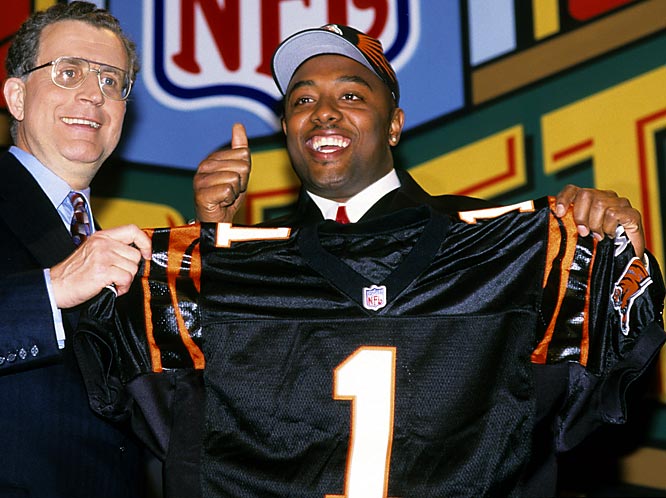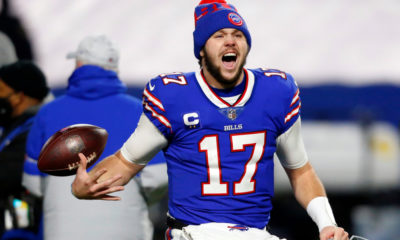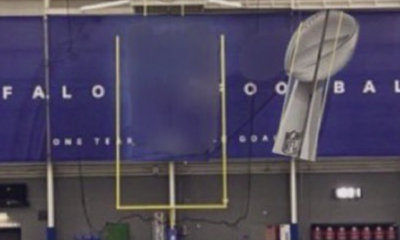
Is draft day really that important, especially with the ability to boost a teams roster via free agency? Yes it is, and it always has been, whether pre or post free agency or salary cap. Obviously pre-free agency the draft was THE method to improve a team other than trade. Today with the advent of free agency and the salary cap, the draft has not lost steam. It is actually just as instrumental if not more to both the success and failure of a team. In the early salary cap years, poor draft picks hamstrung teams as they were forced to negotiate outrageous first round contracts, especially with high draft picks. If a pick failed, the pick set the franchise back until the contract ran out. Today, with the rookie salary cap, salaries of veteran free agents have skyrocketed (especially second tier players), making the draft just as important for a different reason: to supplement a team’s roster with inexpensive talent.
The information below focuses on first round picks and how the results have effected teams of the AFC North. One thing that stands out in this small sample size: choosing a bad quarterback in the first round trumps any other position by a landslide. Picking up a serviceable quarterback via free agency is much easier on a team than a first round bust. Regardless, the correlation between bad drafts and poor seasons seems obvious.
Note: “bust” is defined as a pick that did not pan out for any number of reasons, and not limited to poor play.
Cleveland Browns:
Early in Browns history, they drafted well, and grabbed hall-of-famers spaced out enough to keep them relevant for decades with eight championships, including four in the NFL. Unfortunately their poor drafting began in 1965. Lucky for the Browns, they already had a solid team, and picked HoF Paul Warfield the year prior, which gave them some lag time before things went south. This combo kept the team afloat for another half decade before they struggled during the mid to late 1970s. However, in 1975 the Browns regained their drafting mojo and landed 7 solid picks in 8 years, including Clay Matthews and Ozzie Newsome. The result was a nice run between 1980 to 1989 when the Browns made the playoffs seven times including three AFC Championship games, two of which could easily have been Super Bowl appearances if not for miracle endings. After those glory drafts, the Browns ended their stay in Cleveland with mostly poor first round picks, helping lead them to five of six losing seasons before moving to Baltimore.
After receiving an expansion franchise in 1999, the Browns have struggled with the draft with only a few good first round picks, and none before 2007 (although they did make their one playoff appearance in 2002). However, during that time, they gambled four picks on first round quarterbacks, including three in the last eight years, and have missed on each attempt. Salary cap wise, it doesn’t sting as much as it used to, but its still a wasted first round pick. These misses have been reflected in their record over the past 16 years.
Biggest Busts:
Tim Couch (1st, 1999) – The most important pick in the expansion franchise’s history, and kept them from any early success. While he played a good number of years (5), he was often injured and not productive (64 TDs, 67 INTs).
Mike Phipps (3rd, 1970) – The Browns traded HoF Paul Warfield to the Dolphins for this pick. He was thought to be the next big thing, but instead had sub 50% career numbers and led the team to their worst five year stretch in team history.
Mike Junkin (5th, 1987) – Browns fans are still asking “why?” Junkin was a wasted pick from the start, and did nothing while in the NFL.
Harry Agganis (12th, 1952) – He made the list because of his parent’s sense of humor as they named him. Signed with the Red Sox before playing a snap.
Brady Quinn (22nd, 2009) – Seemed like a steal as he dropped to 22, but apparently that should have been a sign.
Courtney Brown (1st, 2000) – This supposedly dominant pass rusher averaged just over 3 sacks per year for 5 years.
William Green (16th, 2002) – Great on field talent, but DUI, pot, and suspensions did him in. He girlfriend also stabbed him in the back…
Honorable mention: Don Rodgers (18th, 1984 overdose), Trent Richardson (3rd, 2012 – although he netted a subsequent first rounder), the 1973 draft.
Baltimore Ravens:
The Ravens haven’t been around that long to have many first round busts, but they have had their share of early round laughers. They came to Baltimore as a thin team based on more than a decade of poor drafting (1983-1995) in Cleveland, with just a few serviceable first round players on the roster. Beginning in 1996 and leading up to their 2000 Super Bowl, the Ravens amassed seven first round draft picks in five years, hitting on six with one current and one future hall-of-famer, and three other pro-bowlers. After the Super Bowl, the Ravens had four more first round picks in three years, hitting on three with one future HoFer, and one potential HoFer. The one they missed? The position they had been struggling to fill. Quarterback Kyle Boller. While the defense excelled, and the running game was the best in its early history, the Boller led offense stumbled and fumbled its way to early playoff exits and poor seasons. Then came the dreaded drafts of 2004 and 2005 that netted Mark Clayton as the only semi “contributor” out of the 14 total picks. The result on the field was much of the same for the Ravens until the 2008 season. From 2007-2012, the Ravens only missed on one first round pick, and also hit on multiple picks each season helping lead them to a 2012 Super Bowl victory.
Biggest Busts:
Kyle Boller (19th, 2003) – The Ravens were desperate for a QB, and reached at 19. With a defense requiring a game manager to succeed, in his first 3 seasons (34 starts), he threw 32 INTs, was sacked 75 times, and had lost 28 fumbles (and many recovered that stalled drives). What will keep him at the top of this list for eternity is that the coaching staff/front office allowed him to start for the Ravens two years later in 2007 with similar horrible numbers, and would have started opening day 2008 if not for an injury. Oh yes… the Ravens also gave up their 2004 #1 pick to move up from the second round to take him. They essentially took him with a #2 AND a #1 pick.
Travis Taylor (10th, 2000) – The worst of the wide receiver draft busts considering he was a top 10 pick. He caught well under 50% of quarterback targets
Mark Clayton (22nd, 2005) – See Travis Taylor, but with slightly more success. He came to a team with only one receiving option and still couldn’t break through.
Matt Elam (32nd, 2013) – Its still early in his career, but its not looking good at this point. After two full seasons, he weakness are glaring, and he doesn’t seem to have the drive or intelligence to correct them.
Michael Oher (23rd, 2009) – A tough call. He did have moments and helped solidify a Super Bowl winning line when the Ravens moved him to right tackle, but not the player the Ravens hoped for when drafting him. Made a good ending to the movie though…
Honorable mention: The 2004 and 2005 draft classes, additional 2nd round busts: Sergio Kindle, Terrance Cody, and Patrick Johnson.
Cincinnati Bengals:
Despite being an expansion franchise in 1968, they had a good run of success from 1970 through 1977 with three playoff appearances and only one losing season. They drafted well, hitting on most of their first round pick during their initial eight years. It could have been even better however. Their 1969 top pick, QB Gregg Cook, had his career cut short due to injury. Then a string of busts hit the Bengals, with no prominent hits, and major misses. The result was three seasons averaging fewer than five wins per from 1978 to 1980. 1980 was the year they drafted HoF Anthony Munoz in the first. With Munoz and solid QB play, the Bengals enjoyed a 10-year run through 1990 with four playoff appearances, including two Super Bowls. They were extremely inconsistent, however. The Bengals only had five winning seasons during that stretch as they drafted quite a few busts during that run. The busts caught up to them and failed to have a winning season over the next 14 years through 2004. Although they did hit on a few picks during that time, they also had their biggest busts, including two quarterbacks and a running back, two of which were first overall picks. On their third quarterback try since 1992, they landed Carson Palmer, who seemed to have the tools to take them into deep playoff runs. In his first playoff game, he only had one pass attempt before his leg was taken out. The team only made one more playoff appearance over the next five years. Coincidentally, the Bengals only had one other solid first round pick between 1999 and 2005. Two years prior to Palmer’s departure, the Bengals hit solidly on six picks, and have made the playoffs in each of the last four years, and five of the past six.
Biggest Busts:
Akili Smith (3rd, 1999) – After the Browns took Tim Couch, the Bengals set their sights on Smith. He ended his career with a record of 4-13 as a starter, throwing 5 TDs TOTAL in those 17 starts, and 22 games overall.
David Klingler (6th, 1992) – Replaced legend Boomer Esiason and threw 16 TDs… over 4 years.
Ki-Jana Carter (1st, 1995) – His body never really gave him a shot to succeed. He was like the Greg Oden of football.
Jack Thompson (3rd, 1979) – Completely wasted pick. They already had Ken Anderson, and “The Throwin Samoan” didn’t live up to the hype.
David Verser (10th, 1981) – another speedy WR that fizzled in the NFL. He is best known for missing a block in the Super Bowl loss, keeping the Bengals out of the end zone for a game winning score.
Ricky Dixon (5th, 1988) – Another in the good name category. The Bengals picked him 5th, right before Tim Brown, Sterling Sharpe, and Michael Irvin. They did not get better, but the competition did.
Honorable Mention: Peter Warrick (4th, 2000), David Pollack (17th, 2005 injury), Chris Perry (24th, 2004), Ricky Hunley (7th, 1984 held out, traded), Mike Cobb (22nd, 1977), Billy Brooks (11th, 1976), David Verser (10th, 1981)
Pittsburgh Steelers:
The early Steelers (1933-1973) did not enjoy much success, but it wasn’t always due to poor drafts. After all, they did draft hall-of-famers Johnny Unitas, Bobby Layne, and Len Dawson. Unfortunately those three quarterbacks left early and built their HoF credentials elsewhere. It wasn’t until the Steelers drafted a string of four HoF in six years between 1969 and 1974 that they made up for lost time with an amazing run by winning four Super Bowls between the 1974 and 1979 seasons. After that success, the Steelers won just two playoff games TOTAL between 1979 and 1994, and had relatively little success until 2000 considering how week the AFC was from the mid-1980s until the 1997 season. Coincidentally, the Steelers drafted just one first rounder of note between 1979 and 2000: HoF Rod Woodson in 1987. In 2001, the Steelers began another spectacular run of success through the 2010 season with seven playoff seasons, five conference championship appearances (3 wins), and three Super Bowl appearances (2 wins). The Steelers hit on all but one first round draft pick from 2000-2007. Since 2010, the Steelers have not won a playoff game, and only one of their first round picks has made an impact since 2008.
Biggest Busts:
Huey Richardson (15th, 1991) – expected to be a pass rushing force, but only lasted one year with zero sacks and three tackles total in five games.
Mark Malone (28th, 1980) – He started two games in 1981, then not again until 1984. By the time he left Pittsburgh, he boasted a career 50% completion rate with 54 TDs and 68 INTs over his seven seasons. More significantly, because the Steelers had yet to fully evaluate Malone, wanted to boost their defense, and were concerned about a certain someone’s mental fortitude, Pittsburgh decided pass on hometown quarterback Dan Marino in 1983, and instead picked Gabriel Rivera who tragically left the NFL in less than half a season.
Darryl Simms (20th, 1985), Aaron Jones (18th, 1988) – Two of four attempts the Steelers made in the 1980s with their 1st round pick to boost the defensive front. While Rivera mentioned above at least showed promise, these two guys were pushed out the door early due to lack of productivity the worst being Simms who did not start a single game during his two years in Pittsburgh.
Troy Edwards (13th, 1999) – Had a promising rookie campaign, then spiraled down the depth chart during his next two years with the Steelers.
Jamain Stephens (29th, 1996) Drafted as a project late in the first round. He did little on the field, and had a bad work ethic off the field.
Honorable Mention: The rest of the 1988 and 2008 draft classes, Walter Abercrombie (12th, 1982), John Reinstra (9th, 1986), Tom Ricketts (24th, 1989), Kendall Simmons (30th, 2002), Ziggy Hood (32nd, 2009).
Good luck with the draft, AFC North. It might be even more important than you think.





































Facebook
Twitter
RSS